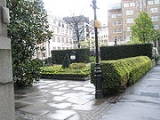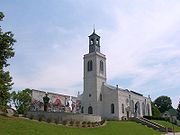
St Mary Aldermanbury
Encyclopedia

City of London
The City of London is a small area within Greater London, England. It is the historic core of London around which the modern conurbation grew and has held city status since time immemorial. The City’s boundaries have remained almost unchanged since the Middle Ages, and it is now only a tiny part of...
, is first mentioned in 1181 but was destroyed by the Great fire of London
Great Fire of London
The Great Fire of London was a major conflagration that swept through the central parts of the English city of London, from Sunday, 2 September to Wednesday, 5 September 1666. The fire gutted the medieval City of London inside the old Roman City Wall...
in 1666. Rebuilt in Portland stone
Portland stone
Portland stone is a limestone from the Tithonian stage of the Jurassic period quarried on the Isle of Portland, Dorset. The quarries consist of beds of white-grey limestone separated by chert beds. It has been used extensively as a building stone throughout the British Isles, notably in major...
by Sir Christopher Wren
Christopher Wren
Sir Christopher Wren FRS is one of the most highly acclaimed English architects in history.He used to be accorded responsibility for rebuilding 51 churches in the City of London after the Great Fire in 1666, including his masterpiece, St. Paul's Cathedral, on Ludgate Hill, completed in 1710...
, it was again gutted by the Blitz
The Blitz
The Blitz was the sustained strategic bombing of Britain by Nazi Germany between 7 September 1940 and 10 May 1941, during the Second World War. The city of London was bombed by the Luftwaffe for 76 consecutive nights and many towns and cities across the country followed...
in 1940, leaving only the walls. In 1966 these stones were transported to Fulton, Missouri
Fulton, Missouri
Fulton is a city in Callaway County, Missouri, the United States of America. It is part of the Jefferson City, Missouri Metropolitan Statistical Area. The population was 12,790 in the 2010 census. It is the county seat of Callaway County...
, by the residents of that town, and rebuilt in the grounds of Westminster College, Missouri
Westminster College, Missouri
Westminster College is a private, selective, liberal arts institution in Fulton, Missouri, USA. It was founded by Presbyterians in 1849 as Fulton College and assumed the present name in 1851. The are located on the campus. The National Churchill Museum is a national historic site and includes...
as a memorial to Sir Winston Churchill
Winston Churchill
Sir Winston Leonard Spencer-Churchill, was a predominantly Conservative British politician and statesman known for his leadership of the United Kingdom during the Second World War. He is widely regarded as one of the greatest wartime leaders of the century and served as Prime Minister twice...
. Churchill had made his Sinews of Peace
Winston Churchill Memorial and Library
The Winston Churchill Memorial, located on the Westminster College campus in Fulton, Missouri, United States, commemorates the life and times of Sir Winston Churchill. In 1946, Winston Churchill delivered his famous "Sinews of Peace" address in the Westminster historic gymnasium...
, "Iron Curtain
Iron Curtain
The concept of the Iron Curtain symbolized the ideological fighting and physical boundary dividing Europe into two separate areas from the end of World War II in 1945 until the end of the Cold War in 1989...
" speech in the Westminster College Gymnasium
Westminster College Gymnasium
Westminster College Gymnasium in Fulton, Missouri was the site of Winston Churchill's March 5, 1946 "Sinews of Peace" speech, in which he stated that "From Stettin in the Baltic to Trieste in the Adriatic, an iron curtain has descended across the Continent." The speech at Westminster College...
in 1946.
The footprint of the church remains in the City, planted with bushes and trees; to this footprint has been added a memorial plaque placed by Westminster College. The gardens also house a monument to Henry Condell
Henry Condell
Henry Condell was an actor in the King's Men, the playing company for which William Shakespeare wrote. With John Heminges, he was instrumental in preparing the First Folio, the collected plays of Shakespeare, published in 1623....
and John Heminges
John Heminges
John Heminges was an English Renaissance actor. Most noted now as one of the editors of William Shakespeare's 1623 First Folio, Heminges served in his time as an actor and financial manager for the King's Men.-Life:Heminges was born in Droitwich Spa, Worcestershire in 1556...
, key figures in the production of the First Folio
First Folio
Mr. William Shakespeares Comedies, Histories, & Tragedies. is the 1623 published collection of William Shakespeare's plays. Modern scholars commonly refer to it as the First Folio....
of Shakespeare's plays and co-partners with him in the Globe Theatre
Globe Theatre
The Globe Theatre was a theatre in London associated with William Shakespeare. It was built in 1599 by Shakespeare's playing company, the Lord Chamberlain's Men, and was destroyed by fire on 29 June 1613...
. Condell and Heminges lived in the St Mary Aldermanbury parish and were buried in its churchyard. This monument is topped with a bust of Shakespeare.
The remains of the church were designated a Grade II listed building on 5 June 1972. The monuments are separately listed.
In the 1830s, the notable missionary
Missionary
A missionary is a member of a religious group sent into an area to do evangelism or ministries of service, such as education, literacy, social justice, health care and economic development. The word "mission" originates from 1598 when the Jesuits sent members abroad, derived from the Latin...
William Jowett
William Jowett
William Jowett was a missionary and author, in 1813 becoming the first Anglican clergyman to volunteer for the overseas service of the Church Missionary Society...
was a lecturer at the church.
Notable burials in the church included the notorious "hanging judge" Judge Jeffreys
George Jeffreys, 1st Baron Jeffreys
George Jeffreys, 1st Baron Jeffreys of Wem, PC , also known as "The Hanging Judge", was an English judge. He became notable during the reign of King James II, rising to the position of Lord Chancellor .- Early years and education :Jeffreys was born at the family estate of Acton Hall, near Wrexham,...
and the Puritan author and minister James Janeway
James Janeway
James Janeway was a Puritan minister and author who, after John Bunyan, had the widest and longest popularity as the author of works read by English-speaking children.-Life:...
and his father, William. Of the interment of Judge Jefferies, Leigh Hunt
Leigh Hunt
James Henry Leigh Hunt , best known as Leigh Hunt, was an English critic, essayist, poet and writer.-Early life:Leigh Hunt was born at Southgate, London, where his parents had settled after leaving the USA...
wrote:
Jeffreys was taken on the twelfth of September, 1688. He was first interred privately in the Tower; but three years afterwards, when his memory was something blown over, his friends obtained permission, by a warrant of the queen's dated September 1692, to take his remains under their own care, and he was accordingly reinterred in a vault under the communion table of St. Mary, Aldermanbury, 2nd Nov. 1694. In 1810, during certain repairs, the coffin was uncovered for a time, and the public had a sight of the box containing the mortal remains of the feared and hated magistrate.

